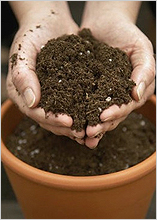Potting Soil For Indoor Plants
Plants grown in containers or pots require a special soil mix for optimal growth due to limited space and drainage issues in pots. Soil or potting mix is a mixture used for growing plants in pots in the garden, home, or terrace.

Typically, such soil should consist of a blend of drainage, moisture-retention components, and nutrients such as potassium, magnesium, calcium, phosphorus, etc. When we talk about soil mix, it usually includes coconut coir, perlite, compost and garden soil. These elements make the soil compatible with the needs of plants, allowing them to thrive.
Different types of plants require different soil mixes. While azaleas, camellias, and hydrangeas thrive in acidic soils, palms and geraniums prefer neutral ones. Fast-growing begonias, petunias, and palms require loose, nutrient-rich soil, while cacti thrive in sandy or rocky soil - the key is to avoid water stagnation in the pot. Orchids, on the other hand, don't need soil in the traditional sense; they grow in a special mix of bark, moss, and fern roots.
Ready-made soil for various types of indoor plants can be purchased at stores. The packaging of quality soil mix usually specifies the plants it's suitable for. However, this is a convenient option for city dwellers, whereas in small towns, there may not always be a store with a wide enough range of ready-made soil substrates for planting. Very often, the entire assortment is limited to packages labeled "Universal Soil." While usable, there's no single soil mix that suits all plants without exception.
Better results can be achieved by adding various components to the universal soil mix, based on the specific soil requirements of individual indoor plants. Preparing soil mix for indoor plants is not difficult and can be done independently.
Components potting soil
You need to know the properties of the main soil components and how to combine them correctly. The following components are most commonly used to prepare soil for indoor plants:
- Garden soil: Adds a certain amount of bulk to the mix, as well as a slew of nutrients and microorganisms.
- Peat moss: Aids moisture retention.
- Pine bark: Improves soil air space.
- Perlite: Decreases soil density and improves water drainage.
- Biochar: Enhances water and nutrient retention.
- Vermiculite: Decreases density but also improves nutrient and moisture retention.
- Coco coir (coconut husks): Improves water retention and soil structure.
- Compost: Adds organic matter and optimizes drainage.
- Limestone: Neutralizes soil acidity and regulates soil pH.
- Sandy soil: Improves soil drainage.
What is the formula for potting mix?
When mixing different components, it's important to adhere to the correct proportions. Usually, care instructions for specific indoor plants suggest something like: a mix of 2 parts topsoil and 1 part leaf soil. This means you need to take some measure (a scoop or a jar) and mix 2 scoops of topsoil and 1 scoop of leaf soil.
The components are determined by volume, not weight: topsoil is heavy, peat is light, and coconut fiber is even lighter.
The components should be evenly mixed, and any lumps should be removed or crushed.

Sterilizing Soil
Soil collected in the forest or meadow may contain adult insects or their larvae. Worms and beetles in a flowerpot are harmful!
Even if you're confident in the benefits of earthworms, don't rush to introduce them into the pot with the plant. All living organisms need food. Without food in the limited space of a flowerpot, they will start feeding on the roots of planted plants.
Soil may also contain spores of pathogenic fungi, which can thrive in warm and humid conditions.
Before composing the soil mix for plants, it's very important to disinfect all its components. The health of plants depends on this.
You can heat the components of a particular soil mix in the oven. You can treat them with insecticides and fungicides. You can freeze them in winter - if the temperatures are low, there's a high chance of unwanted soil inhabitants dying, and the soil structure improves.
In extreme cases, simply put the prepared soil in some metal container and heat it on the stove or a campfire. You'll be surprised how much life emerges on the surface, trying to escape overheating.
Soil sterilization is a controversial issue. There's a established balance of microflora in the soil, which processes organic residues to feed plants. Sterilization of soil kills this microflora.
However, on packages of ready-made substrates, on bricks of coconut fiber, for example, you may encounter labels stating that the product is sterile, processed at high temperatures.
How to choose for the best potting soil
When you are buying potting soil from the market run your hands on the packet to understand the following:
- The soil should not feel tightly packed and should feel soft
- It should not feel too damp or too dry
- Look for ingredients- it should contain vermiculite, peat moss, perlite, etc. These make the soil aerated and ensure moisture retention and no water clogging.
- It should contain organic fertilizer like compost, manure, etc.
And, most importantly, when preparing the soil mix, read the requirements for the soil composition for each specific plant carefully, as they may vary significantly. We wish you success in preparing high-quality soil for your indoor plants.
If you have any further questions or need clarification on any part, feel free to ask!




